
| Moscow Aviation Institute | school 2 «Engines for Flying Vehicles» | department 201 «Theory air-breathing jet engine» | Experimental Research in Combustion |

|
|
|
Scientific Group «Experimental Research in Combustion»:
Activity
Up
|
| Test-bench number | 1 | 2 | 3 |
| Denomination | Three-stage flame heater | One-stage flame heater (combustion chamber) | Small-scale one-stage flame heater |
| Temperature range (K) | 400-2100(2300) | 1400-2400 | 600-2050 |
| Flow Mach number | 1.4; 1.5; 2.2; 2.5; 2.7; 3.0; 3.5 | 1.1; 2.3 | 0.2 -1.0 |
| Mass flow range (kg/s) | 0.8 — 8.0 | 0.8 — 4.0 | 0.2 — 1.5 |
| Pressure range (bar) | 1.3 — 48 | 1.5 —6 | 2 — 48 |
| Oxygen molar mass fraction (%) | 7-29 | 0-24 | 5-24 |
| Size of exit cross section of nozzle (mm) | 212 x 40 340 x 33 |
100 x 80 | D = 18, 25 |

| Range of model flow conditions |
| — | Clear heating |
| Mass flow rate (kg/s) | 0.04-0.60 |
| Total pressure (bar) | 2-40 |
| Temperature (K) | 300-900 |
The test facilities are provided with special equipment to measure parameters of high-temperature supersonic flow: pressure (total and static), temperature (total and static), heat flux (range 0.3-3 MW/m2). A cooled Pitot rake is used for pressure measurements. For temperature measurements we apply thermocouples and infrared imaging. Heat fluxes are measured using specific probes (designed together with department 204).
Infrared monitoring system Thermacam PM 695 allows measurement of the temperature of different surfaces in the range -40 ... 2000 � C with an accuracy of 2%.
Digital 2-color pyrometer IGAR-12LO allows local non-contact surface temperature measurement in the area 0.5-2.5 mm (metal, ceramics, graphite, and others in the range: 500-2200 � C with accuracy of measurements 0.5% of the measured value).
Specialized high temperature pressure transducers XTEH-10LAC-190 (M) SERIES for measuring pressure fluctuations in liquids and gases make it possible to investigate rapidly varying gas dynamics.
Specifications: pressure - 7 bar, temperature - up to 500 � C, frequency - 10-25000 Hz.
Microphone Bruel & Kjaer 4938 is designed to measure the sound level of the gas jet in a closed room with no sound-absorbing surfaces. Specifications: The dynamic range at least 40 - 180 dB. The frequency range at least 4Hz - 70kHz. Data acquisition and control are organized by using high-performance system based on National Instruments equipment.
The deadweight gauge MP-250 (inaccuracy � 0.05%) vacuum manometer IMP-2.5 (inaccuracy � 5 Pa) are used for pressure sensors verification with laboratory accuracy.
The scientific research group, intended to study thermogasodynamic processes in hypersonic scramjet, was established in 1969 at MAI, Faculty 2 «Engines for Flying Vehicles», Department 201 «Theory of Air-Breathing Jet Engines».
The group founders were people from the «Krasnaia Zvezda» (Red Star) design bureau, commissioned by the order of Chief Designer Michail M. Bondariuk. The main test equipment was obtained from the NII TP research institute (Keldysh Research Center at present). Under Aleksander Zaslavsky`s supervision, creation of a new laboratory and test facilities was started.
The most active and efficient research work on the development of scramjet combustion chamber concept was done in 1977-1990, when the laboratory was directed by Prof. Sergey I. Baranovsky under scientific patronage of Prof. Genrih N. Abramovich. During this time laboratory had effective cooperation with TMKB «Souz» (Turaevo). In reward for this work, a Prize of the USSR Council of Ministers was awarded to the laboratory scientific staff in 1989. In the area of investigation, scientists defended their dissertations (Prof. PhD. S.I. Baranovsky, Prof. Dr. V.M. Levin, Dr. V.N. Avrashkov, PhD. I.V. Konovalov, PhD. A.I. Turischev, PhD. N.P. Nikolenko, PhD. V.V. Lutsenko).
From the beginning of 90-s there was almost no state financing of the scramjet research. Most of the staff quitted the laboratory.
At the same time, the gained experience in the area of complex combustion experiments and important scientific results attracted attention of several European aviation and missile firms. In 1992 the laboratory was reformed into the «Aerospace» scientific center and international projects started. «Aerospace» was directed by PhD. Vadim M. Levin. The main partner became the French Aerospatiale (MBDA-France at present). Besides experimental studies were made under contracts with Airbus (France), Snecma (France), MTU (Munich, Germany).
International projects helped not only to save and upgrade test facilities but also to essentially improve the measurement equipment. New specialists grew for efficient work in such a complex area as the experimental research in thermogasodynamics of reacting supersonic flow.
Thanks to the international cooperation, the MAI specialists were in touch with the state of the art and participated in projects aimed at preparation of the hypersonic flight. Today this work is continued at Faculty 2 of MAI by the scientific group «Experimental Research in Combustion» under direction of Dr. Valery N. Avrashkov.
Since 2004 the collaboration between MAI and MBDA France obtained status of military and technological cooperation according to Russian Presiden`s decree. The main purpose of this cooperation is to prepare flight tests of a wide-range scramjet on a hypersonic vehicle.
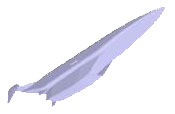
|

|
Creation of operational scramjet-based propulsion systems depends on the solution of two key problems:
Although successful solution of these problems can be only confirmed by the flight test, many preliminary results can be obtained from ground tests and numerical simulations (thermogasodynamics, mechanical stresses,...).
The present work, conducted in the frame of different research projects and technological programs, is aimed at the technologies related to the manufacturing of combustion chamber main elements as well as at obtaining of satisfactory performances, thermal and mechanical reliability. The main problems in this scope are:
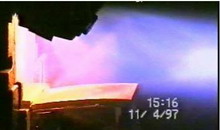 |
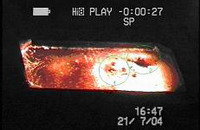 |
 |
On the other hand, prior to start a costly technological program of flight experiment, it is mandatory to demonstrate the ability to predict, with sufficient margins, the aero-propulsive balance (generalized thrust-minus-drag balance).

|
To make this crucial step MBDA France and ONERA head the LEA program, which is conducted in collaboration with Russia. The «Experimental Research in Combustion» group of MAI takes an important part in this collaboration.
Main directions of the LEA program:
Started in January 2004, this program is planned to end in 2013 after 4 autonomous flight tests of the experimental vehicle in the Mach number range from 4 to 8.
Step by step, the main design guidelines of the LEA experimental vehicle and its propulsion system have been defined and finally confirmed by a Preliminary Design Review early in 2006.

|
Today, Phase 2 of the program is running. It will provide a detailed design of the hypersonic vehicle for the first series of free jet ground tests, which are supposed to start in 2010, for obtaining the thrust and aerodynamic performances.
At MAI, after the development of a new vitiated air heater, a water-cooled model of the variable-geometry combustion chamber (with a 2/3 width) has been tested under conditions corresponding to the flight Mach number range from 2 to 7+ first using H2 and kerosene and then a CH4/H2 mixture as fuels. Today, a new full-scale, full-width combustion chamber model is under preparation for the next test series, which will start in 2009.
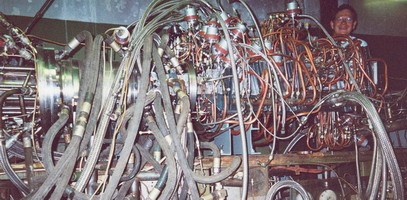
|
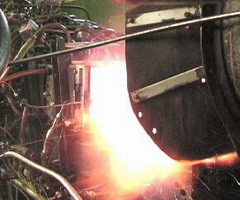
|
© 2012 Moscow Aviation Institute | Experimental Research of Combustion
|